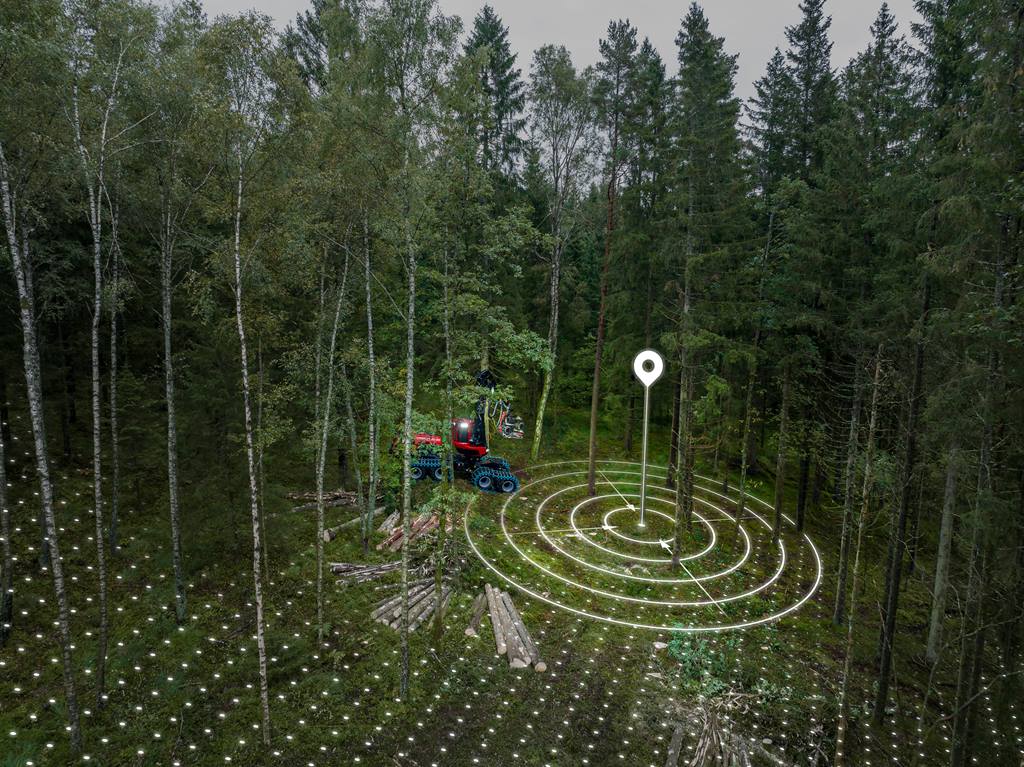GPS positioning has long been used in forestry and has helped in the development of work methods, facilitated collaboration, and increased productivity. However, an error margin of 0–10 meters has meant fairly inaccurate positioning. Until now. Today’s new RTK GNSS technology enables positioning with an error margin of just a few centimeters, paving the way for countless possibilities and even heralding a paradigm shift to a smarter forestry.
“The new technology is a prerequisite for future solutions, but already today we can offer the exciting new MaxiFleet function Precision, which delivers valuable information and active operator support,” says Jörgen Nilsson product Manager for Connected Products.
Mark exact boundaries
One new feature is that the operator can use geofencing – a digital fence that is added when planning an area. This could be around a harvesting area or to mark protected areas such as ancient monuments or charcoal pile remains. This feature means greater peace of mind for forest owners and operators alike as it indicates more clearly where the operator should harvest and the areas they should avoid. Geofences can also be linked to alarms to warn the operator when the machine or the crane tip is approaching such a boundary.
“This means that the machine operator can safely harvest close to an area boundary without the risk of harvesting the neighbor’s trees,” Jörgen continues.
View the machine on a map
Since the machine’s position can be determined with great precision, the user can also see the machine in the map program – including the direction of the crane and the location of the crane tip. This extreme precision enhances the practical usability of the map layer data for the operator. Another advantage of the new technology is that the machine’s route is plotted with significantly better accuracy, making the planning more effective.
“The introduction of RTK GNSS technology also provides opportunities for a new way of working. Today, most forest companies have to physically walk around the forest to mark trees – and in winter this can mean skiing on deep snow. Thanks to this new technology, boundaries and specific trees can be marked digitally, based on map data from, say, drones or LiDAR scanning,” Jörgen explains.
Keep track of the logs
In MaxiFleet the operators have since long been able to see where a tree was felled, but with the greater precision now available, the exact position of each felled log can be shown. This lets the operator know exactly where the timber is located, even in the dark or when covered with snow. This will also make it easier to see the assortment found in each log pile or at the roadside.
“This also offers future development potential. For instance, one plausible function would be to let the machine keep track of the timber volume until the operator believes it’s time to turn around and start loading so that the logs fit the load space,” Jörgen continues.
Easier to classify silvicultural considerations
Another new function is stem code visualization, which means that individual stems can be visualized using stem codes based on, for example, biodiversity considerations.
Stem coding supports the operator in their work, enabling them to make better decisions more easily and making it easier to follow directives, such as for the distance between future trees. Based on previously coded trees, MaxiFleet can also suggest when it is time to cut a high stump or leave a tree standing, making the operators work easier. It can also keep track of the number of high stumps, meaning one less thing for you to worry about.
“Aside from making your work easier, stem code visualization helps show that the work has been conducted correctly and in accordance with the forest owner’s instructions,” Jörgen concludes.
About the new technology in MaxiFleet Precision:
The GNSS system uses several satellite systems to determine positions. This refinement has been enabled by the arrival of several new satellites, including the commissioning of Galileo, the European GNSS system.
RTK (real-time kinematic) positioning. Accurate positioning using satellite data requires more known measurement points to help correct the satellite’s signals. Previous technology has been based on only the machine having a signal receiver, but thanks to networked RTK, the machine now has access to several fixed reference stations. These are used to correct any errors in the satellite signals, thereby improving positioning precision from several meters to a few centimeters.
Work with precision

Smart Forestry
May 16, 2023
Digital developments unfold at a fast pace, and for forestry this means opportunities for new, smarter ways of working. Thanks to developments in the satellite positioning technology GNSS, MaxiFleet, Komatsu Forest fleet management system, can now show the machine’s position within just a few centimeters, providing the foundation for a new and exciting function, Precision.
